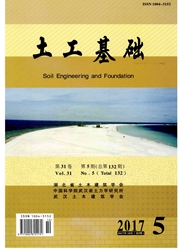

 中文摘要:
中文摘要:
在盐矿地层中建造地下油气储库群,是国际上广泛采用的能源储备方式。为了论证在金坛深部盐岩地层中建造大型储气库的可行性,针对金坛盐岩的区域地质构造特性和层状盐岩赋存特性,开展了相关物探和地质特性研究工作。研究结论如下:(1)金坛盐盆的沉积构造边界受周围几条断层控制,但这些断层如今已不活动,属于压性断层,密闭性较好;(2)区域内盐岩层主要分布于始新统阜宁组四段,呈盐岩与非盐夹层韵律分布,水平构造、向四周渐趋尖灭,厚度达68~231m,盐质较佳,储库潜力十分巨大;(3)盐层上覆盖层和下伏底板均为封闭性能较好的泥岩、石膏岩等致密岩层构成,有利于拟建储气库的密封性。综上可知:金坛盐盆的区域封闭性和稳定性极为良好,可作为储气库建造的较好备选场址。
 英文摘要:
英文摘要:
Energy storage caverns constructed in salt formations is one of the most widely adopted patterns in the world. To ex- plore the feasibility of storage clusters in the Jintan deep salt mine, the geophysical explorations and research works have been performed on the regional geological and tectonic characteristics as well as the geological occurrence of the salt mine. The fol- lowing conclusions have been obtained: 1) the sedimentary boundaries of Jintan salt basin are controlled by several faults. These faults, which are currently inactive, belong to the compressional faults, and have fairly gas tight character. 2) The salt mines mainly deposit in the fourth section of Fu-Ning Group, Eocene Series. The salt layer and other layers are horizontally al- ternatively deposited. The salt layers are gradually wedging out in all directions. In the center area of salt basin, the thickness of salt is in range of 68-231m with a good engineering property. The salt rock in this area has a great potential for the energy storage. (3) Both the overlying and the underling rock consist of mudstone, glauberite and other very low permeability rock formations. They have excellent gas tight property for the proposed storage-clusters. In conclusion, the regional stability and tightness of Jintan salt basin are satisfactory and can be selected as the candidate site for energy storage clusters.
 同期刊论文项目
同期刊论文项目
 同项目期刊论文
同项目期刊论文
 期刊信息
期刊信息
